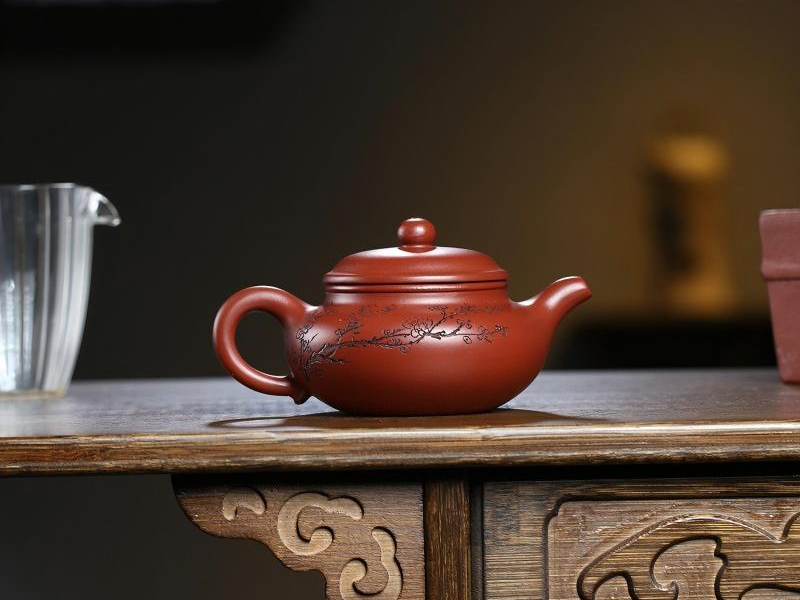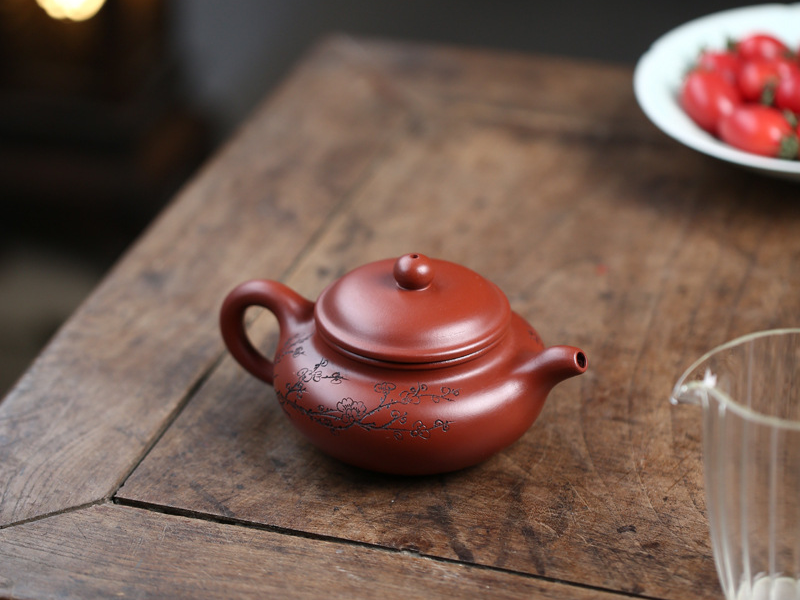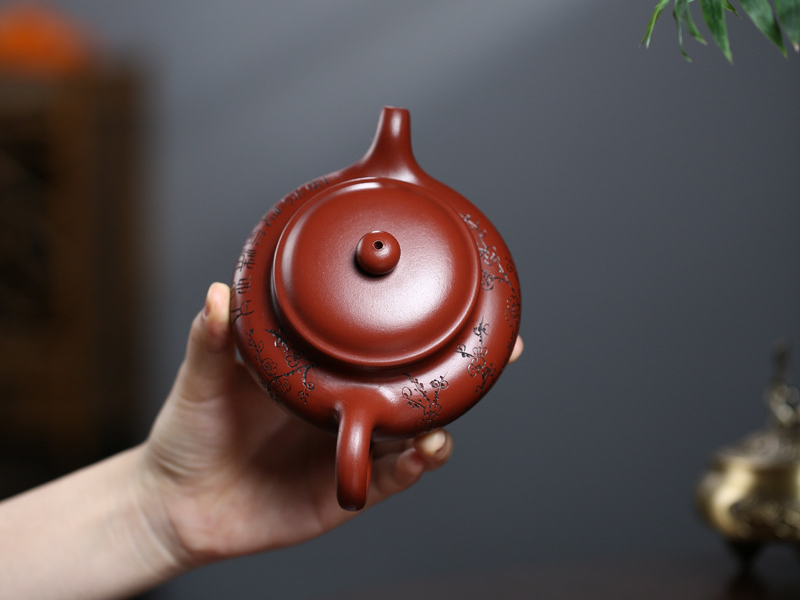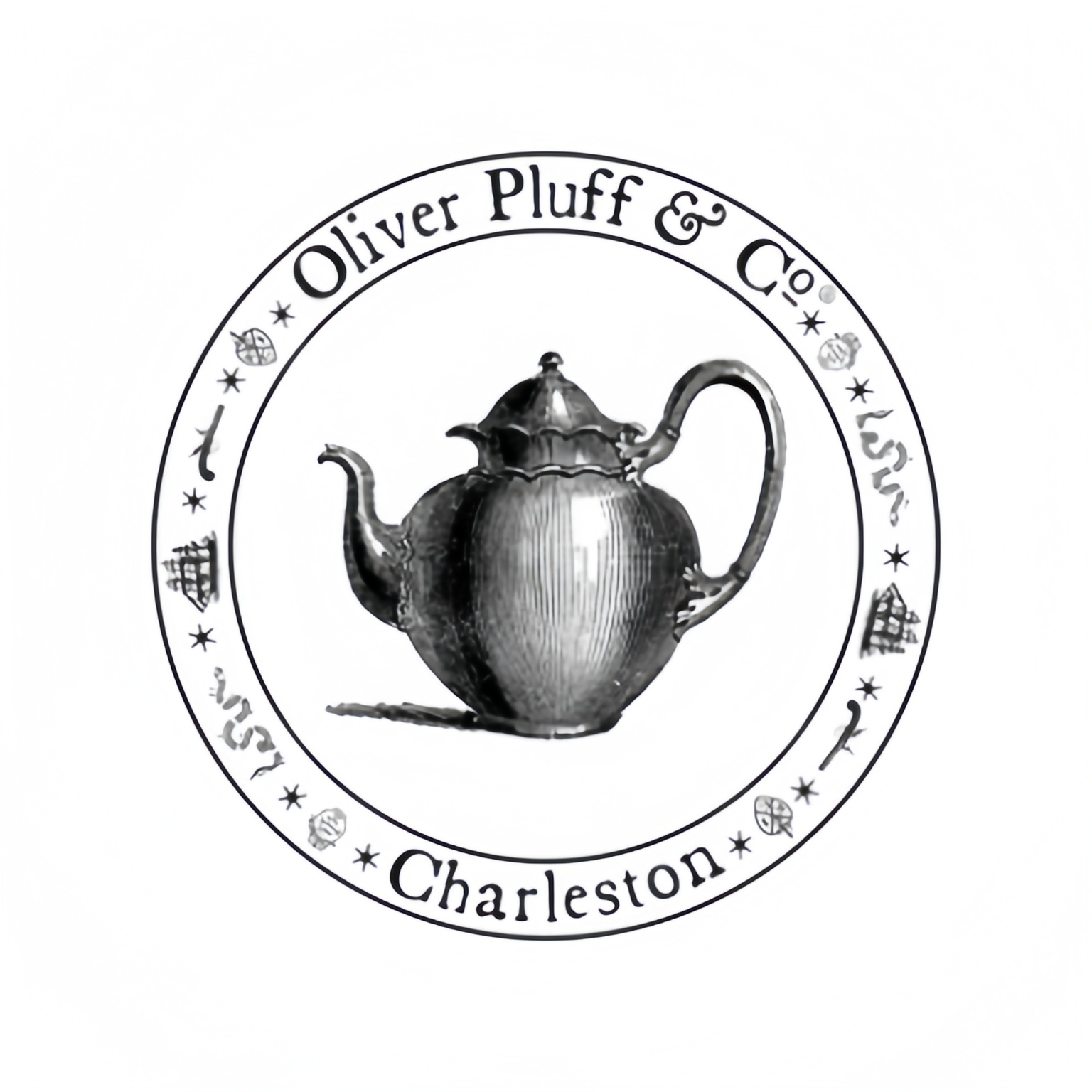Chinese Yixing Zisha Teapot with Refined Elegance
Welcome to the intersection of a historic tradition and timeless art form. Here, on the page for our Chinese Yixing Zisha Teapot with Refined Elegance, you are met with an instrument that doesn’t just steep tea, but transforms the whole experience into a meditative ritual, embedding each cup with history, flavor, and refined elegance. This is no mere teapot, but a heritage piece, a testament to exquisite craftsmanship, and a companion that ages with you with each filled cup.
Application Scenarios Expansion
Which industries and people do prefer Yixing Zisha Teapot?
The charm and appeal of the Yixing Zisha teapot and especially a teapot with “refined elegance” goes well beyond its practical function and application and it can be found in in many places and with many sophisticated individuals:
Tea Lovers and Enthusiasts: This is the most direct audience. Those who appreciate the subtle flavors of fine teas, especially Oolongs, Pu-erhs, and Black Teas, often seek Yixing teapots for their distinctive ability to enhance taste and aroma over time. The “refined elegance” aspect caters to those who view teaware as an integral part of the aesthetic and sensorial experience of drinking tea.
Collectos of Fine Teaware and Ceramics: Yixing teapots – especially those most artistic and well-made – are highly collectible. The “refined elegance” of such a teapot would define it as a worthy addition to a collection, due to the beauty of the teapot, the craftsmanship of the maker, and the quality of Zisha clay.
Tea Ceremony and Mindful Living Practitioners: For people who conduct traditional tea ceremonies (e.g., Gongfu Cha) or tea drinkers who interact with tea drinking consciously with a meditative approach, the Yixing teapot is often an essential vessel in their tea practice/lifestyle. Aspects like its history, organic material, and meticulous brewing method promote mindfulness and connect people with the process and heritage of the product.
Luxury Gift Market: A charming and refined Yixing Zisha teapot is a great idea for the perfect gift for a wedding, milestone anniversary, gifting to important clients, or anyone who appreciates fine workmanship and cultural tradition.
Luxury Tea Shops and Specialty Retail Stores: Establishments that market themselves as purveyors of the premium – both in terms of the teas they stock and the experience they offer their customers – often buy and sell genuine Yixing teapots (which really are great for brewing most oolongs and puerh). A “refined elegance” model would be very at home displayed amid a refined luxury atmosphere and add desirability
Cultural Institutions and Educators: Museums, cultural centers, and educators focusing on Chinese art, history, or tea culture might use such teapots for display, demonstration, or educational purposes.

Other than its functionality, a well- developed Zisha teapot is also a fine piece of art. It can also be used as an elegant decorative object at home, in the study or office. It is also a representation of a type of cultural collectible and a sense of understated luxury.
What types of goals and dreams might the acquisition of this teapot be able to fulfill?
Although it doesn’t solve “problems” in the traditional sense of the word, this Yixing Zisha teapot solve several kinds of desires and improve many aspects of the tea-drinking ritual:
The Desire for Better Flavor: The extraordinary subtley of Zisha clay is its porosity. It absorbs aromatic tea oils through each steeping, so the pot becomes seasoned with tea, and eventually enriches the flavor, aroma and texture of each subsequent brew. The Teapot unlocks your best leaves’ full potential.
Connect More Deeply With Your Tea Heritage: In its own little way, owning and interacting with an Yixing teapot is kind of like integrating yourself with hundreds of years of Chinese tea culture and artisan craft. The “refined elegance” of this particular pot is proof of the high artistic standards extant in this tradition.
Creating a personal tea ritual: The act of making tea in an Yixing pot—warming the pot, measuring the leaves, the attention to multiple infusions—slows you down, and helps you establish a personal ritual that can bring a few moments of calm, focus, and pleasure to each day.
A Long-Term Companion: If properly used and cared for, a teapot like this can last for generations. This is no disposable object—a good yixing pot is an investment that will only appreciate in character and monetary (and sentimental) value the more that you use it.
Authenticity and purity: authentic Yixing teapots are unglazed on the inside. Zisha clay is a natural material. Ordinarily, this appeals to people who want their food and drink to be in contact with “natural”, “untainted” materials.
An Explanation of Cultural Impression: Possessing one’s own Yixing teapot – especially one of “refined elegance” – demonstrated one to be of cultured taste and appreciative of quality and artistry in relation to tea and tea culture.
The tea-brewing experience made me feel that a few seconds tacked on to the total time would be added benefit. Tea brewing is a multisensory practice, a minimalist teapot not only has to look pleasing, have a nice tactile quality, gracefully balance itself when cradled in hand but also pour with glamour.

FAQ
Here are some of the popular FAQs on Yixing Zisha teapot that users are generally interested to know about.
The uniqueness of Yixing Zisha teapots resides predominantly in the clay from which they are made: Zisha (紫砂), or “purple sand” clay, and from which comes the common English-language name of “Purple sand” teapots. This naturally occurring clay is found only in Yixing in Jiangsu province in China. The clay exhibits a number of unusual properties:
Porosity: Zisha clay is fairly porous, although also very dense and water-tight when fired. As Zisha clay teapots are used, minute traces of oils from the brewed tea are absorbed and eventually build up within the pot over time. This provides an enhanced taste and aroma to each subsequently brewed tea. This is sometimes called “seasoning” the teapot, and the build-up of oils and fine tea particles that aid in developing the teapot’s “patina” or “glaze” with continued usage is called the ” patina” or “en
Mineral Content: The mineral content of the ore the clay produced from gives the clay its distinctive texture and color when fired, as well as the tea’s “tangible” flavour. Some of these minerals include: iron oxide, quartz and kaolinite.
Heat Retention: Yixing teapots have good heat retention, helping in maintaining a stable temperature when brewing tea. This is important for bringing out the full flavor of certain teas that require higher temperature such as oolongs and pu-erhs.
Craftsmanship: Traditionally, Yixing teapots are made by hand. Unique slab-building techniques have been handed down for generations, and it is the artists and their traditions that adds artistic value to the teapots.
Cultural Heritage: They are deeply rooted in Chinese tea culture and history, reflecting a high-level sophistication in the art of making and consuming tea.
Seasoning a new Yixing teapot is an important ritual to remove any clay dust from firing and to prepare it for brewing. A common method involves:
Rinse: Thoroughly rinse the teapot (inside and out) with warm water to remove any loose particles. Avoid soaps or detergents.
Initial Boil (Optional but Recommended): Submerge teapot and lid separately in a clean pot of filtered water, make sure the parts are not knocking against each other (you can wrap them in cloth). Bring up to a gentle boil and simmer for around 30 min ~ 1 hour, this will help open the pores and clean the clay well. Let it completely cool in water.
Tea Infusion: After the first boil and cool and discarding that water, fill the teapot with the leaves of the kind of tea it’s to be used for most often. Fill with water pour hot water over the leaves in the pot, put the lid on, and let steep for some hours or overnight. Others set the teapot (full of leaves and water) into a pot of brewing tea for a couple of hours.
The last rinse: Strain the tea leaves and steeping water. Rinse the teapot with hot water. And your teapot is seasoned and ready for your first brew. You want the clay to start to absorb the tendencies of one kind of tea.
Maintenance Remember that the illustrations highlight some of the unique properties of Yixing teapots.
After Each Use:
Promptly empty any used tea leaves from your Yixing teapot
Rinse Yixing teapot thoroughly with hot water
Never use soap, any sort of detergents, or abrasive scrubbers to clean your Yixing teapot. They will strip away the precious tea seasoning and might remain of the teapots surface, flavoring the next tea you brew.
Airdry: let your teapot airdry with lid off or ajar. Do make sure the teapot is dry completely before put it away to avoid moisture trapped inside the teapot creating mold. Store teapot in ventilated place and avoid places with strong odor, such as kitchen, incense burn area, or other places. porous clay can absorb that odor like a sponge.
Gentle Wiping: You can gently wipe the surface with a clean soft cloth. Handling and wiping will help the develop a desirable patina over time.
Avoid Sudden Temperature Changes: Do not subject the teapot to sudden, extreme temperature changes (e.g., rinsing a hot pot with very cold water), as this could significantly increase the chances of cracking.
Yes, this is the most highly recommended practice favoured by most Yixing teapot users. The the Zisha clay is porous and absorbs the oils and aromatic compounds of the tea brewed in the teapot.
Flavor purity: When brewing many different styles of tea (for example, a smoky Lapsang Souchong, followed by a gentle Green Tea), the absorbed flavors can begin to bleed into each other, clouding a brew’s flavor characteristics.
Better Seasoning: by committing a pot to a given type of tea (eg oolongs, or even one subdivision of oolongs like Tie Guan Yin oolongs), or teas with similar profiles (eg various roasted oolongs), the seasoning the teapot develops in the porous clay will be more suited to that type of tea specifically. For example, one might want to use one pot for raw Pu-erh, and another for ripe Pu-erh, and another for Taiwanese high-mountain oolongs, and one for Wuyi rock oolongs. This will lead to the cleanest, most enhanced taste experience for each type of tea.
What does having “Refined elegance” mean, for us to analyse what particular features may help to indicate their presence? “Refined elegance” means more than a teapot which is well constructed and fit for purpose, superiere features are present and contribute to an additional sense of sophisticated aestheticism. Features which demonstrate refinement and elegance might be:
High quality Clay and Finish: The Zisha clay could be of particularly high and refined nature so that when fired it is particularly smooth and lustrous in nature; the way that the surface and patina has been laid may itself have a well executed revelatory finish, perhaps semi-gl
A balance in proportion and form between all parts of the teapot: the body, the spout, the handle, the lid and knob. The lines are pleasing, the form either classic or unique, or a modern twist that is elegant and streamlined.
Perfect Execution: e.g. the fit of the lid, the smoothness of the flow of water from the spout, the comfortable feel of the handle in the hand of the pourer, the accurate execution of any incised or applied decoration.
Objects workshop . The Subtle Arts: Elegance is often a matter of the opportunity to be subtle. It may be that any decoration is subtle in any area, or that there is some fine carving of decoration or mark of the maker, or merely that the form of the piece is beautiful so that it has no need of any other kind of decoration. It avoids the ornateness or
Unique Design Features: It may have a different shape the others don’t or a unique handle design OR the spout has a elegant curve that subtly sets it apart. So in other words, “refined elegance” means a product with a high degree of skill, detail and beauty that it the product beautiful in itself, and causing it to be timeless.
Each clay has its own benefits:
Yixing zisha: Again, it’s porous, seasons over time, enhances certain tea types (oolongs, pu-erhs, black teas), offers good heat retention. Good for a connoisseur interested in cultivating the character of their teas.
Porcelain/Ceramic: Porcelain is always glazed and non-porous, which means that it is neutral and will not take on any flavours. You can therefore brew any tea in a porcelain teapot. It is particularly suitable for more delicate green, white and floral teas where it is important that the original flavours be experienced to the full.
Glass: Also non-porous and neutral. The main advantage of glass vessels is they’re transparent: allowing the user to visually appreciate the unfurling of the tea leaves and the color of the liquor during the steeping process. Glass teaware is perfect for blooming teas and are otherwise appropriate for all tea types. In general, glass vessels have worse heat retention properties than Zisha or thick porcelain vessels.
Cast Iron (Tetsubin): If there is one type of teapot which is known for an almost unparalleled ability to keep tea hot, it should be cast iron pots. Japan’s traditional tetsubin (Japanese cast iron teapots) are used over open flames to boil water. Alternatively, cast iron pots used to brew tea are enameled inside, since the iron would otherwise rust and/or flavor the tea. Cast iron properly separated from the tea (by a coat of glaze) is a neutral material akin to porcelain: the choice depends on the type of tea one wishes to brew, how one would like the flavor to develop over time, and what aesthetic qualities are desired.

Selection/Comparison Suggestions
Picking the perfect teapot is up to the individual! Chinese Yixing Zisha Teapot with Refined Elegance This teapot is made for the individual who wants the unique way Zisha clay interacts with tea
| Feature |
Yixing Zisha (Refined Elegance) |
Glazed Ceramic/Porcelain Teapot |
Glass Teapot |
| Material |
Unglazed Zisha Clay |
Glazed Clay/Porcelain |
Borosilicate Glass |
| Flavor Impact |
Enhances specific teas over time (due to porosity & seasoning) |
Neutral (does not absorb or alter flavor) |
Neutral (does not absorb or alter flavor) |
| Best For Teas |
Oolongs, Pu-erhs, Black Teas |
All teas, especially Green, White, Aromatic Teas |
All teas, Blooming Teas |
| Heat Retention |
Excellent |
Good to Very Good |
Moderate |
| Aesthetics |
Earthy, traditional, artistic, develops patina; “Refined Elegance” implies superior form & finish |
Wide variety of styles, colors, patterns |
Modern, transparent, showcases tea |
| Maintenance |
Specific: rinse with water only, air dry, dedicate to one tea type |
Easy: can use mild detergent if needed, versatile |
Easy: dishwasher safe (often), versatile |
| Durability |
Durable if handled with care, but can chip/break |
Can chip/break |
Can break, thermal shock resistant (borosilicate) |
| Key Appeal |
Flavor enhancement, cultural heritage, collectible, personal connection |
Versatility, true flavor representation, diverse designs |
Visual appeal, simplicity, versatility |
Comparison with other Teaware:
Choose This Yixing Zisha Teapot If:
You drink primarily Oolongs, Pu-erhs, or Black teas and want to dedicate a pot to relish their distinctive features.
You value good craftsmanship and you know that teapot is not just a utensil – but a piece of art.
You like the process of making tea, and the idea of having a pot grow with you.
You want something “refined elegance”, which means good and also a little bit understated.
You are a collector (or aspire to be), and you value authenticity and old world, hand-crafted traditions.
If you’re likely to move between lots of different teas, especially particularly delicate ones, or ease of cleaning with detergents is important to you, then a good quality porcelain or glass teapot might be a more flexible first choice, or a complementary one to a more dedicated Yixing pot.
Actual Cases/Customer Stories (Illustrative Examples)
The Choice of the Tea Master:
“Master Lin, a tea ceremony master in his own right, recently purchased our ‘Refined Elegance’ Yixing teapot for his private tea tastings. ‘The balance of this teapot is superb,’ he said. ‘Its pour is true, like the stroke of a calligrapher’s brush. With my aged oolongs, already it has begun to deepen their resonance. The quiet poise of its shape do not draw attention to itself, but intensifies the stillness of the Cha Dao (Way of Tea). It is indeed, a vessel of refined elegance.'”
A Collector’s Treasure:
“Eleanor is an avid collector of antique and artisan teaware. ‘I have many Yixing pots,’ she says, ‘but this one won me over with its unblemished finish and graceful strokes. It’s a modern classic. I’ve assigned it to my favorite single origin Dian Hong (Yunnan Black Tea), and the richness it imbues my brews is none short of heavenly. It rests on my display shelf like a sculpture, a fixture in my collection admired by all guests who visit.'”
The Everyday Ritual:
“James received this teapot as an anniversary gift from his wife. ‘I used to brew my tea in a mug. This Yixing teapot has changed my morning routine; brewing tea with it is such a meditative process. I’ve since started experimenting with loose leaf tea, and I’ve come to realize how much better it tastes. It’s not just a teapot; it’s an experience. And my wife says it looks pretty sitting on our kitchen counter even when it’s not in use!'”
Bridging Cultures:
“Sophia is a university lecturer in East Asian studies. She employs a similar elegant Yixing pot in her seminars on Chinese culture: ‘For my students, seeing and understanding the Yixing teapot firsthand — its material, the purpose it is put to, the stories told with it — make the culture that much more tangible. This teapot, with its refined design, perfectly demonstrates the merging of utility and artistry at the core of the Chinese aesthetic. A lovely teaching tool — and a joy to use myself.'”























Tyrone Butler –
Skeptical at first but now I’m a believer. This teapot has transformed my daily tea ritual into something truly special and meditative.
Serena Phan –
Perfect size for solo brewing sessions. The clay’s porosity really does improve the tea’s character. Best purchase I’ve made this year.
Hayden King –
Elegant design meets superior function. My jasmine green tea has never tasted this nuanced before. Impressive traditional craftsmanship throughout.